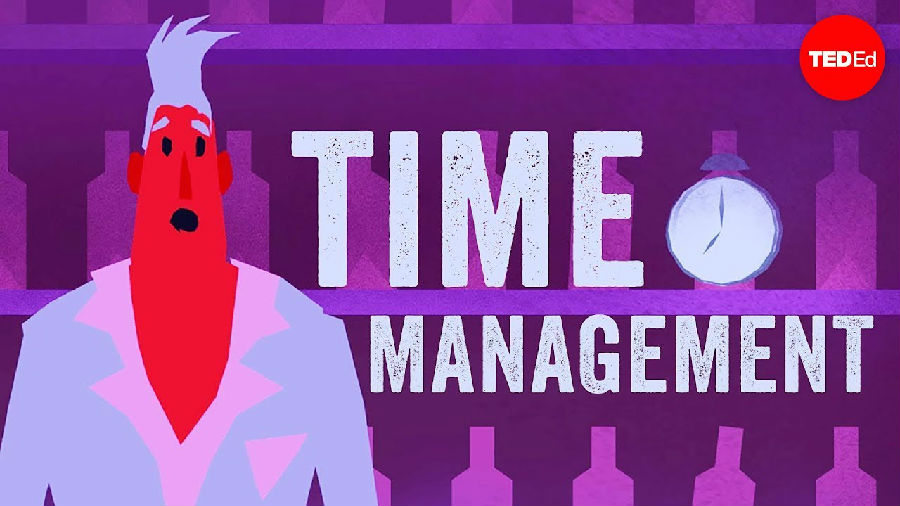(单词翻译:单击)
In the summer of 1997, NASA's Pathfinder spacecraft landed on the surface of Mars,
在1997年的夏天,美国航天局探索者飞船降落在火星表面,
and began transmitting incredible, iconic images back to Earth.
向地球传输令人惊叹不已的、标志性的图像。
But several days in, something went terribly wrong. The transmissions stopped.
但是几天后,出现了一些严重的问题。传输停止了。
Pathfinder was, in effect, procrastinating: keeping itself fully occupied but failing to do its most important work.
探索者出现了拖延现象:虽然排满了工作,但没做最重要的任务。
What was going on? There was a bug, it turned out, in its scheduler.
这是怎么回事?原来在时刻表中有一个程序错误。
Every operating system has something called the scheduler
每一个操作系统都有一个时刻表,
that tells the CPU how long to work on each task before switching, and what to switch to.
在中央处理器转换前通知处理时间段以及切换到哪个任务。
Done right, computers move so fluidly between their various responsibilities,
若处理得当,计算机会在不同任务间切换自如,
they give the illusion of doing everything simultaneously.
因此会给人一种它在同时处理所有事物的幻觉。
But we all know what happens when things go wrong.
但是我们都知道如果操作不当会导致什么后果。
This should give us, if nothing else, some measure of consolation.
如果别无其他,这至少能给我们稍许安慰。
Even computers get overwhelmed sometimes.
即便是计算机,有时也会崩溃。
Maybe learning about the computer science of scheduling can give us some ideas about our own human struggles with time.
也许学习关于计算机科学的任务规划,能给我们人类如何处理棘手的时间问题带来一些启发。
One of the first insights is that all the time you spend prioritizing your work is time you aren't spending doing it.
第一:我们花在给事情做优先级排序的时间意味着我们一件具体的事情都没做。
For instance, let's say when you check your inbox, you scan all the messages, choosing which is the most important.
例如,当你查看收件箱你会浏览所有的信息,选出最重要的。
Once you've dealt with that one, you repeat. Seems sensible, but there's a problem here.
一旦你处理完一个,你重复相同的动作。看上去非常合理,但是存在一个问题。
This is what's known as a quadratic-time algorithm.
这就是计算机学科里著名的二次时间算法。
With an inbox that's twice as full, these passes will take twice as long and you'll need to do twice as many of them!
当一个收件箱信件变两倍,它们需要两倍时间来运行,你要处理的数量也是两倍!
This means four times the work.
这意味着工作总量翻了四倍。
The programmers of the operating system Linux encountered a similar problem in 2003.
操作系统Linux的程序员们在2003年遇到了类似的问题。
Linux would rank every single one of its tasks in order of importance,
Linux会根据每个任务的重要性来进行排序,
and sometimes spent more time ranking tasks than doing them.
有时将任务排序的时间还多于执行任务的时间。

The programmers' counterintuitive solution was to replace this full ranking with a limited number of priority "buckets."
程序员反直觉的解决方案就是把这完整的排序换掉,换成数量有限的优先级桶。
The system was less precise about what to do next but more than made up for it by spending more time making progress.
这个系统会降低下一步做什么的准确性,但是却花了更多的时间来完成任务。
So with your emails, insisting on always doing the very most important thing first could lead to a meltdown.
因此关于你的邮件,总是坚持先完成最重要的会导致崩溃。
Waking up to an inbox three times fuller than normal could take nine times longer to clear.
打开一个比平常多三倍的收件箱会花费长达九倍的时间来处理。
You'd be better off replying in chronological order, or even at random!
你最好按时间顺序来回复,或者甚至随机回复!
Surprisingly, sometimes giving up on doing things in the perfect order may be the key to getting them done.
令人惊讶的是,有时放弃用完美的顺序来执行任务也许才是把任务完成的关键。
Another insight that emerges from computer scheduling has to do with one of the most prevalent features of modern life: interruptions.
从计算机日程安排中产生的另一种与现代生活关联最多的问题是各种干扰。
When a computer goes from one task to another, it has to do what's called a context switch,
当计算机从一个任务进行到另一个任务时,它需要执行称为上下文切换的任务,
bookmarking its place in one task, moving old data out of its memory and new data in.
给每一个任务标一个书签,将内存中之前的数据移出,导入新的数据。
Each of these actions comes at a cost.
每一次这样的行为都会产生代价。
The insight here is that there's a fundamental tradeoff between productivity and responsiveness.
此处有一个重要的、存在于生产效率和反应能力之间的权衡问题。
Getting serious work done means minimizing context switches.
完成重要任务意味着要减少上下文切换。
But being responsive means reacting anytime something comes up.
但是反应迅速则意味着对随时发生的任务进行反馈。
These two principles are fundamentally in tension.
这两个原则孰轻孰重令人难以取舍。
Recognizing this tension allows us to decide where we want to strike that balance.
意识到这个取舍难题,可以让我们决定我们要在哪里达到平衡。
The obvious solution is to minimize interruptions. The less obvious one is to group them.
显而易见的解决方式就是减少各类干扰。退而其次的方式是分组。
If no notification or email requires a response more urgently than once an hour,
如果没有通知或电子邮件紧急到需要在一小时内响应,
say, then that's exactly how often you should check them. No more.
那么你一小时检查一次即可。不用更频繁了。
In computer science, this idea goes by the name of interrupt coalescing.
在计算机科学中,这个概念被命名为中断合并。
Rather than dealing with things as they come up
与其处理随时出现的事情,
Oh, the mouse was moved? A key was pressed? More of that file downloaded?
喔,鼠标动了?摁了个键?下载更多的文件?
the system groups these interruptions together based on how long they can afford to wait.
系统分组会将根据这些干扰问题能等多久,将它们放在一起。
In 2013, interrupt coalescing triggered a massive improvement in laptop battery life.
在2013年,中断合并极大地延长了笔记本电池的寿命。
This is because deferring interruptions lets a system check everything at once, then quickly re-enter a low-power state.
这是因为推迟处理干扰可以让系统一次性检查完毕,然后快速重新进入低电量模式。
As with computers, so it is with us.
不仅计算机如此,我们也是这样的。
Perhaps adopting a similar approach might allow us users to reclaim our own attention,
也许采用一个相似的方式能让我们用户重新集中注意力,
and give us back one of the things that feels so rare in modern life: rest.
以及给我们当代生活中极为珍贵的一个回馈:休息。


